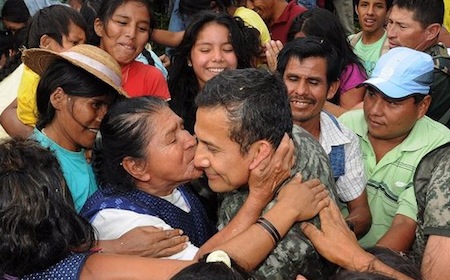July 28 marked the one-year anniversary of Ollanta Humala (pictured above) as Perú’s new president — and it was marked by the appointment of Humala’s third prime minister since taking office.![]()
The fear that many Peruvians had about Humala’s administration turned out to be a non-issue — whereas many Peruvians once feared that Humala would disrupt a decade-plus of staggering economic growth by turning Perú toward charisma nationalism. Although the Peruvian economy keeps chugging along, however, social unrest has turned out to be a thornier problem for Humala.
The 2011 presidential campaign ended in a runoff between the two most polarizing candidates among five plausible presidents: the leftist Humala, the 2006 runner-up and a former Army officer, and Keiko Fujimori, the daughter of Alberto Fujimori, Perú’s president in the 1990s. Mario Vargas Llosa, the Peruvian Nobel laureate, famously compared the choice as being akin to terminal cancer and AIDS — despite reservations about Humala, Peruvians also worried that Fujimori would pardon her father, currently in prison for committing embezzlement and for committing human rights abuses during his time in office, unleashing demons from an era that many Peruvians would rather not revisit.
When Humala won by a 3% margin, however, he moved quickly to assure Peruvians that he wouldn’t disrupt the booming economy, promptly appointing as his finance minister Luis Miguel Castilla, a deputy finance minister from the previous administration of Alan García. Far from nationalizing Peruvian industry, Humala has essentially left economic policy unchanged from his predecessors of the past decade.
Félix Jiménez, Humala’s top campaign economic adviser, who briefly served as a presidential economic adviser, left Humala’s government in January 2012, and has since criticized Humala for being too beholden to orthodox economic policy and Peruvian economic elites. Another former adviser, Oscar Dancourt, a former acting Central Bank president, also left the administration.
Those resignations were also, in part, a response to a December reshuffle that brought Oscar Valdés — an army officer and former military colleague of Humala’s — to power as prime minister. His appointment caused several prominent leaders, including former president Alejandro Toledo, to decry the growing militarization of the Humala administration.
Valdés’s resignation last week, and his replacement by Peruvian justice and human rights minister Juan Jiménez, seems calibrated to adjust to many of those criticisms, which are tied to some of Humala’s biggest problems. Jiménez had increasingly become a key troubleshooter for Humala, especially in contrast to the increasingly unpopular Valdés.
Chief among those problems, however, are the protests that have emerged in the mostly-indigenous Cajamarca and surrounding region in the northern highlands (in South America, as far as culture goes, it is said that altitude often matters more than nationality, but that holds true for politics and economic policy as well).
There, the controversial $5 billion “Conga project” has become perhaps the most polarizing issue of Humala’s administration. The project would further develop the Yanacocha gold mine, Latin America’s largest, which has brought significant wealth to the northern highlands (although not necessarily to many of the residents). As part of the development, however, the US-based Newmont has controversially proposed moving water from four mountain lakes to nearby reservoirs, despite protestations from locals that it would disrupt the water. Clashes between protesters and the Peruvian government led Humala to declare a state of emergency in December and again recently, and up to fifteen protesters have been killed recently in clashes with Peruvian authorities.
To make matters worse, there’s some evidence that remnants the once-quashed leftist Shining Path movement is gaining steam once again in Southern Perú 20 years after its original leader Abimael Guzmán was captured. Humala, in his days as an army officer, was responsible for many of the operations intended to defeat the Shining Path, and his record is not without blemishes — he has been accused of human rights violations from his days in the army.
Meanwhile, in a superb article earlier this week in Foreign Policy, Michael Shifter notes that Humala’s family has also caused him political problems — his wife is rumored to wield significant behind-the-scenes power, his brother is in jail for treason, essentially, and his father has renounced him as a neoliberal sellout.
Humala’s approval ratings, having slipped to around 40%, are still much higher than either those of Toledo or García when they left office. While Humala has much farther to fall, he still has at least four years to make his mark on Peruvian policy and, despite setbacks, the Peruvian people still seem willing to give Humala’s administration a chance to live up to its potential.
in South America, the yardstick for success, especially on the center-left, remains former Brazilian president Luiz Inácio Lula da Silva. Even if Humala’s odds of calming Perú’s social tension and maintaining its economic growth remain strong, he’s still no Lula — a figure that Humala openly admired and emulated as a presidential candidate.
Like Lula, Humala has pledged to redistribute some of the gains of the Peruvian economy over the last decade, such as through a wide-ranging system like Brazil’s Bolsa Família (Family Allowance), a direct cash stipend program adopted by Lula that provides capital to Brazil’s poorest families in exchange for the vaccination and education of their children. Mexico adopted a similar program, Oportunidades, in 2002. So far, though, Humala has yet to enact anything so sweeping — Perú’s own conditional cash transfer program, Juntos, introduced in 2005, affects just a tiny sliver of Perú’s poorest citizens.

One thought on “One year into the administration of Perú’s Ollanta Humala: a mixed bag”